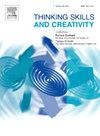Origami-based collaborative spatial problem-solving: Multimodal observational study
IF 4.5
2区 教育学
Q1 Social Sciences
引用次数: 0
Abstract
The study examined students' spatial collaborative problem-solving behaviors when engaging in a design task dependent on spatial reasoning. Thirty undergraduate students working alone and collaboratively were tested on performance differences in solving an origami Sonobe cube as an active hands-on spatial problem solving task. Epistemic network analysis and sequential pattern mining were conducted to reveal the relationships among collaborative problem solving behaviors and students' embodied engagement displayed in low - versus high-performing student pairs. The core findings were that successful student pairs (higher scores on their final sketches) engaged more in sketching and gesturing in their collaborative problem-solving process, whereas their less successful peers engaged more in trial-and-error or heuristic experimentation by manipulating the origami units. This study can contribute to developing specific pedagogical strategies that better prepare students for collaboration on tasks that require a high level of spatial cognition.
基于折纸的协作空间问题解决:多模态观察研究
该研究考察了学生在参与依赖于空间推理的设计任务时的空间协作解决问题的行为。本研究测试了30名单独和合作的大学生在解决一个折纸索诺贝立方体作为主动动手解决空间问题任务时的表现差异。通过认知网络分析和序列模式挖掘,揭示了低水平和高水平学生对协作解决问题行为与学生融入度之间的关系。研究的核心发现是,成功的学生(在最终草图上得分更高)在合作解决问题的过程中更多地参与素描和手势,而他们不太成功的同龄人则更多地通过操纵折纸单元进行试错或启发式实验。这项研究有助于制定具体的教学策略,更好地为学生在需要高水平空间认知的任务中进行合作做好准备。
本文章由计算机程序翻译,如有差异,请以英文原文为准。
求助全文
约1分钟内获得全文
求助全文
来源期刊

Thinking Skills and Creativity
EDUCATION & EDUCATIONAL RESEARCH-
CiteScore
6.40
自引率
16.20%
发文量
172
审稿时长
76 days
期刊介绍:
Thinking Skills and Creativity is a new journal providing a peer-reviewed forum for communication and debate for the community of researchers interested in teaching for thinking and creativity. Papers may represent a variety of theoretical perspectives and methodological approaches and may relate to any age level in a diversity of settings: formal and informal, education and work-based.
 求助内容:
求助内容: 应助结果提醒方式:
应助结果提醒方式:


